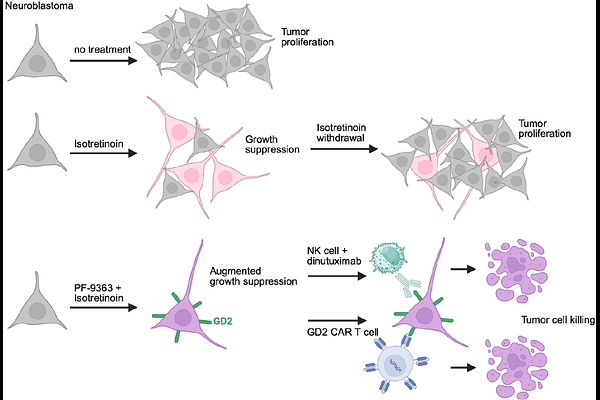KAT6A/B inhibition synergizes with retinoic acid and enhances the efficacy of GD2-targeted immunotherapy in neuroblastoma

KAT6A/B inhibition synergizes with retinoic acid and enhances the efficacy of GD2-targeted immunotherapy in neuroblastoma
Weichert-Leahey, N.; Berezovskaya, A.; Zimmerman, M. W.; Alvarez-Caldero, F.; Winschel, M.; Salhotra, S.; Mabe, N. W.; Perez-Atayde, A.; Vitorino, F. N. d. L.; Garcia, B.; Gerdemann, U.; Stegmaier, K.; Durbin, A.; Oldridge, D.; Abraham, B.; Look, A. T.
AbstractHigh-risk neuroblastoma accounts for about 15% of childhood cancer deaths and arises from precursors of the peripheral sympathetic nervous system. Retinoids are clinically used to inhibit growth of neuroblastoma cells through reconfiguration of the regulatory enhancer landscape. Its effects, however, are completely reversible after drug withdrawal, leading to rapid tumor cell proliferation. Here, we sought to identify epigenetic modifiers that potentiate the antiproliferative effects of retinoids in neuroblastoma. We identified PF-9363, an inhibitor of the histone H3K23 acetyltransferases KAT6A/B, as synergistically inhibiting neuroblastoma growth in combination with retinoids. PF-9363 plus retinoids induces durable growth arrest, which persists beyond retinoid withdrawal in vitro and in vivo with sustained Polycomb-mediated repression of oncogenic transcription factors MYCN, PHOX2B and GATA3. Moreover, PF-9363 plus retinoids increases GD2 expression, rendering neuroblastoma cells more sensitive to anti-GD2 immunotherapy. Overall, our studies demonstrate that KAT6A/B inhibition increases the effectiveness of retinoids and GD2-targeted immunotherapy in neuroblastoma.